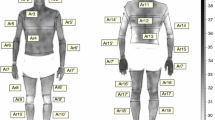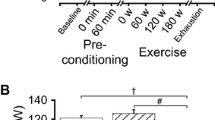Summary
The capacity of different types of exercise to rewarm the body, especially the feet, was studied. Six healthy male subjects wearing winter clothing (2.4 clo, 0.37° C·m2·W−1) were exposed on three occasions to −15° C for 120 min. For the first 60 min the subjects were cooled while sitting motionless and for the latter 60 min they were submitted to cycle ergometer exercise (CE), arm ergometer exercise (AE) or step exercise (ST). The rate of work in CE (about 350 W) served as a reference value for AE and ST. The cooling resulted in an average 1.7 (SEM 0.03) °C decrease in mean body temperature (T b) corresponding to a 425 (SEM 9) kJ heat debt. The ST increased most effectively mean skin, rectal and lower body skin temperatures as well as dry heat loss. The ST increased T b by 0.83 (SEM 0.16) °C, CE by 0.10 (SEM 0.11) °C and AE by only 0.07 (SEM 0.12) °C. At the end of the exercise the foot temperature was approximately 6°C higher in ST than in CE. The superior rewarming by ST was apparently due to its low mechanical efficiency. Because the increase in T b could not explain all the changes in foot temperatures, increased circulation and metabolism of the feet would also appear to have been involved.
Similar content being viewed by others
References
Allwood MJ, Burry HS (1954) The effect of local temperature on blood flow in the human foot. J Physiol 124:345–357
Andersen KL, Shephard RJ, Denolin H, Varnauskas E, Masironi R (1971) Fundamentals of exercise testing. World Health Organisation, Geneva
Andersen KL, Masironi R, Rutenfranz J, Seliger V, Degré S, Trygg K, Orgim M (1978) Habitual physical activity and health. World Health Organisation Regional Publications European Series no. 6, Copenhagen
Asmussen E, Nielsen M (1947) The regulation of the body-temperature during work performed with the arms and with the legs. Acta Physiol Scand 14:373–382
Åstrand I (1977) Work physiology (in Swedish). Almquist and Wiksell, Stockholm
Ayling JH (1986) Regional rates of sweat evaporation during leg and arm cycling. Br J Sports Med 20:35–37
Borg G (1970) Perceived exertion as an indicator of somatic stress. Scand J Rehabil Med 2:92–98
Cooper T, Randall WC, Hertzman AB (1959) Vascular convection of heat from active muscle to overlying skin. J Appl Physiol 14:207–211
Davies CTM, Barnes C, Sargeant AJ (1971) Body temperature in exercise: effects of acclimatization to heat and habituation to work. Int Z Angew Physiol Einschl Arbeitsphysiol 30:10–19
Durnin JVGA, Womersley J (1974) Body fat assessed from total body density and its estimation from skinfold thickness: measurements on 481 men and women aged from 16 to 72 years. Br J Nutr 32:77–97
Gisolfi C, Robinson S (1970) Venous blood distribution in the legs during intermittent treadmill work. J Appl Physiol 29:368–373
Hellstrøm B (1966) Hand and foot circulation during standard exposure. Acta Univ Lund, Sect II no. 15:15 p
Hellstrøm B, Berg K, Vogt Lorenzen F (1970) Human peripheral rewarming during exercise in the cold. J Appl Physiol 29:191–199
ISO (1984) Moderate thermal environments — Determination of the PMV and PPD indices and specification of the conditions for thermal comfort. International Standards Organisation no. 7730, ISO, Geneva
Kaciuba-Uscilco H, Kozlowski S, Brzezinska Z, Nazar K, Turski B, Boruta A (1975) Blood catecholamines and thyroxine at rest and during exercise in men exposed to cold. In: Jansky L (ed) Depressed metabolism and cold thermogenesis, Charles University, Prague, pp 68–72
Kaufman WC (1983) The hand and foot in the cold. Physician Sportsmed 11:156–158
Kruk B, Pekkarinen H, Harri M, Manninen K, Hänninen O (1990) Thermoregulatory responses to exercise at low ambient temperature performed after precooling or preheating procedures. Eur J Appl Physiol 59:416–420
Ludbrook J (1966) Aspects of venous function in the lower limbs. Thomas, Springfield, Ill.
Minard D (1970) Body heat content. In: Hardy JD, Gagge AP, Stolwijk JAJ (eds) Physiological and behavioral temperature regulation. Thomas, Springfield, Ill., USA, pp 345–357
Mitchell D, Wyndham CH (1969) Comparison of weighting formulas for calculating mean skin temperature. J Appl Physiol 26:616–622
Nielsen M (1938) Die Regulation der Körpertemperatur bei Muskelarbeit. Skand Arch Physiol 79:193–230
Pegum JM, Fegan WG (1967) Physiology of venous return from the foot. Cardiovasc Res 1:249–254
Pivarnik JM, Grafner TR, Elkins ES (1988) Metabolic, thermoregulatory, and psychophysiological responses during arm and leg exercise. Med Sci Sports Exerc 20:1–5
Rapaport SI, Fetcher ES, Shaub HG, Hall JF (1949) Control of blood flow to the extremities at low ambient temperature. J Appl Physiol 2:61–71
Roth GM, Horton BT, Sheard C (1940) The relative roles of the extremities in the dissipation of heat from the human body under various environmental temperatures and relative humidities. Am J Physiol 128:782–790
Sawka MN, Gonzales RR, Drolet LL, Pandolf KP (1984a) Heat exchange during upper- and lower-body exercise. J Appl Physiol 57:1050–1054
Sawka MN, Pimental NA, Pandolf KB (1984b) Thermoregulatory responses to upper body exercise. Eur J Appl Physiol 52:230–234
Veghte JH, Adams WC, Bernauer EM (1979) Temperature changes during exercise measured by thermography. Aviat Space Environ Med 50:708–713
Werner J, Heising M, Rautenberg W, Leimann K (1985) Dynamics and topography of human temperature regulation in response to thermal and work load. Eur J Appl Physiol 53:353–358




